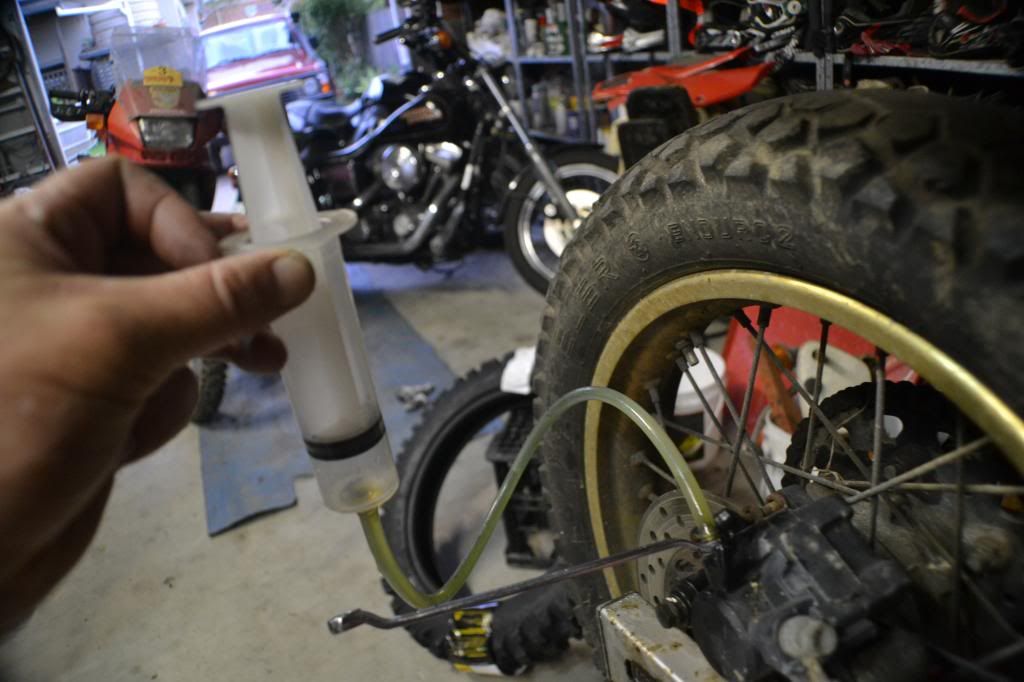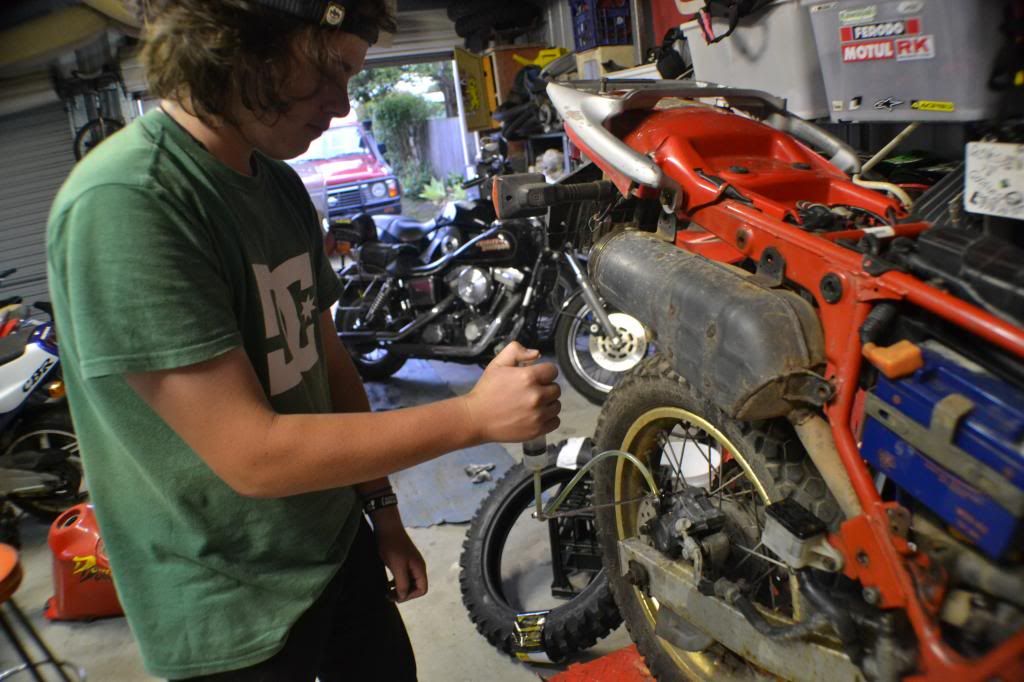Home › Forums › Do It Yourself Videos, Photo Posts Helpful Hints › Do It Yourself Videos, Photo Posts Helpful Hints › Brakes, doing a reverse bleed
This topic contains 9 replies, has 0 voices, and was last updated by Justin Williams 13 years ago.
-
AuthorPosts
-
November 7, 2012 at 7:50 pm #102052
Last night I was mucking around with my Scrapheap adventure NX650 and the rear brakes needed bleeding, so I did a reverse bleed on them as this is the easy way to bleed the brakes.
This is a trick that TB showed me years ago and I have used it ever since.
For those that don’t know this handy trick I will endeavor to explain.
Anyone that has bled brakes will know the usual method of filling the top reservoir, pumping up some pressure with the pedal or lever and once you have some pressure, hold the pedal/lever in and at the same time release the pressure at the bleed screw on the caliper. Hopefully forcing any air out of the system, via the bleed screw. This can be a frustrating and time-consuming affair, as you may have to do it several times to get rid of the “spongy” feel.
To do a reverse bleed is a much easier method.
The equipment you need to do a bleed via this method is very cheap and readily available.
What you need is a large syringe and a short piece of silicone aquarium air hose, assembled and connected to the bleed screw like so.

The syringe needs to be full of brake fluid at this stage. You then force the brake fluid into the caliper with the syringe via the bleed screw, it is always a good idea to have a piece of rag wrapped around the reservoir to catch any over flowing fluid. By doing the bleed this way it forces the air in the system to take it’s natural coarse upwards and out of the top of the reservoir.
I managed to pry the Xbox controls out of Connor’s hands for a minute so he could demonstrate.

I do all my bike brakes this way now and it makes changing the brake fluid a quick and easy job, you are more likely to do it on a regular basis once you have learnt this method.
November 7, 2012 at 8:37 pm #232146I have done it that way a few times myself Mick and it usually works but for some reason occasionally I can’t get the fluid to go through.
…..and yes the bleeder has been open.
November 7, 2012 at 8:41 pm #232150Jeffro wrote:I have done it that way a few times myself Mick and it usually works but for some reason occasionally I can’t get the fluid to go through.…..and yes the bleeder has been open.
I have come across the same problem Jeffro and upon inspection I found the small hole in the bleed screw was blocked with gunge.
November 7, 2012 at 9:17 pm #232151This method works well. Have to do my Berg as the front brakes have gone west after sitting for so long. Why do Brembo brakes loose pressure/get air in them when left sitting? How do you prevent it?
November 7, 2012 at 9:25 pm #232155Good question Jimmy
After my 3 month holiday in WA my front brakes were gone
There was still a liitle left so I put a cable tie around the lever and after a couple of days it was all good again?????????
Strangest thing???????
Thanks to who ever it was who showed me that trick.
Cheers
Murph (Kato 500)November 7, 2012 at 9:58 pm #232156jimmy wrote:This method works well. Have to do my Berg as the front brakes have gone west after sitting for so long. Why do Brembo brakes loose pressure/get air in them when left sitting? How do you prevent it?I used to get that with my 450EXC when it hadn’t been used for a while and found a quick fix was to get a screwdriver onto the brake pads and pry them off the disc pushing the pistons back into the calliper. Then just pump the brake lever to push the pistons/pads back into position and the problem is solved (usually).

I think they get an air bubble in the brake fluid reservoir piston somehow. Try the “fix” next time and see how it goes.Mickp
November 7, 2012 at 10:08 pm #232147micknmeld wrote:This is a trick that TB showed me years ago and I have used it ever since.To do a reverse bleed is a much easier method.
The syringe needs to be full of brake fluid at this stage. You then force the brake fluid into the caliper with the syringe via the bleed screw, it is always a good idea to have a piece of rag wrapped around the reservoir to catch any over flowing fluid. By doing the bleed this way it forces the air in the system to take it’s natural coarse upwards and out of the top of the reservoir.
quote]
Yes, as you say it makes life easy to bleed the brakes. I also use a second syringe to suck the fluid from the reservoir to help prevent the brake fluid spillage.

Its an easy way to bleed the brakes or flush out the old fluids with new brake fluid.Mickp
November 8, 2012 at 4:31 am #232148I have just discovered this on my bike too! Will try your quick fix mickp…..

And your brake fluid change idea Mick….next time
justo
November 21, 2012 at 9:21 am #232149The screw driver in the pads trick worked! Great tip thanks!!
November 21, 2012 at 9:48 pm #232763jimmy wrote:The screw driver in the pads trick worked! Great tip thanks!!+ 1

-
AuthorPosts
You must be logged in to reply to this topic.